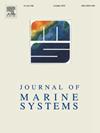在冬春过渡和La Niña条件下探索洪堡群岛上升流物候和高频水文变化
IF 2.5
3区 地球科学
Q2 GEOSCIENCES, MULTIDISCIPLINARY
引用次数: 0
摘要
智利中北部(南纬29-30°)科金博外海的上升流系统提供了多种生态系统服务,包括洪堡群岛的高生物多样性,这有利于人类福祉。群岛上升流的影响,以及导致时间水文条件(温度、pH值和氧气)变化的其他高频过程,可能对该生态系统的功能产生深远影响。在这项研究中,我们探索了上升流物候(频率、强度和持续时间),以及高频变异性分析(半日、日和天气),以及2022年8月至11月群岛水柱的垂直结构。这一时期对应于2022年的南方冬春过渡,这也标志着一个延长的La Niña事件的结束,在此期间,我们分析了四个月的连续地面风和地面(10米)和地下(30米)水文测量以及四次水文测量。在整个研究期间观测到的上升流事件导致了温度(−1.1°C)、氧气(−79 μmol kg−1)和pH(−0.18 pHNBS)的负水文异常,有时持续长达一周。天气尺度在冬季主导了水文变化(占方差的48%),而日分量在春季变得更加显著(占方差的37%),可能是由于更高的太阳辐射和更宽的pH/氧循环。受浮游植物生物量调节,低pH (<;7.8 pHNBS)和缺氧条件(<;在整个研究期间,群岛30 m以下以60 μmol kg−1居多。进一步的研究可能会解决这种环境变化对与洪堡群岛生产力有关的生物过程的影响。本文章由计算机程序翻译,如有差异,请以英文原文为准。
Exploring upwelling phenology and high-frequency hydrographic variability in the Humboldt Archipelago during winter-spring transition and La Niña conditions
The upwelling system off Coquimbo in central-northern Chile (29–30°S) provides multiple ecosystem services, including the high biodiversity in the Humboldt Archipelago, which benefits human well-being. The influence of upwelling in the archipelago, along with other high-frequency processes that lead to changes in temporal hydrographic conditions (temperature, pH, and oxygen), may have profound effects on the functioning of this ecosystem. In this study, we explored the upwelling phenology (frequency, magnitude, and duration of upwelling events), together with high-frequency variability analyses (semidiurnal, daily, and synoptic), and the vertical structure of the water column in the archipelago from August to November 2022. This period corresponded to the austral winter-spring transition of 2022, which also marked the end of a prolonged La Niña event, during which four months of continuous surface wind and surface (10 m) and subsurface (30 m) hydrographic measurements were analyzed along with four hydrographic surveys. Upwelling events observed throughout the study period promoted negative hydrographic anomalies in temperature (−1.1 °C), oxygen (−79 μmol kg−1), and pH (−0.18 pHNBS), sometimes lasting up to a week. The synoptic scale dominated the hydrographic variability during the winter (48 % of the variance), whereas the diurnal component became more significant during the spring (37 % of the variance), likely due to higher solar radiation and wider pH/oxygen cycles. Moderated by phytoplankton biomass, low pH (< 7.8 pHNBS) and hypoxic conditions (< 60 μmol kg−1) prevailed below 30 m depth in the archipelago throughout the study period. Further studies may address the influence of this environmental variability on biological processes related to the productivity of the Humboldt Archipelago.
求助全文
通过发布文献求助,成功后即可免费获取论文全文。
去求助
来源期刊

Journal of Marine Systems
地学-地球科学综合
CiteScore
6.20
自引率
3.60%
发文量
81
审稿时长
6 months
期刊介绍:
The Journal of Marine Systems provides a medium for interdisciplinary exchange between physical, chemical and biological oceanographers and marine geologists. The journal welcomes original research papers and review articles. Preference will be given to interdisciplinary approaches to marine systems.
 求助内容:
求助内容: 应助结果提醒方式:
应助结果提醒方式:


